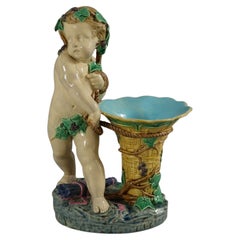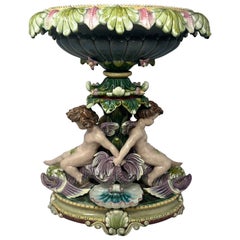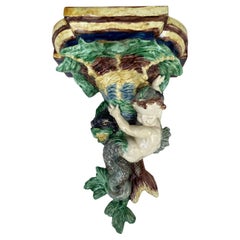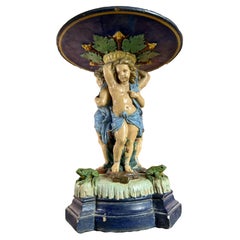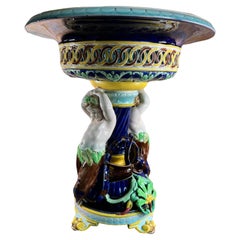Majolica With Putti
Minton Majolica Putti with Basket Vase
By Minton
Located in Chelmsford, Essex
Minton Majolica figural vase which features a putti holding a basket, with a quiver of arrows
Category
Antique 1860s Victorian Vases
Materials
Majolica
Antique French Majolica Porcelain Hand-Painted Centerpiece with Putti Circa 1900
Located in New Orleans, LA
Substantial Size Antique French Majolica Porcelain Hand-Painted Centerpiece with Putti, Circa 1890
Category
Antique Late 19th Century French Centerpieces
Materials
Porcelain
$5,700
H 20.25 in W 16 in D 9.5 in
19th Century French Majolica Palissy Wall Bracket Shelf With Putti Merman
By Thomas Sergent
Located in Austin, TX
Large 19th Century French Majolica Palissy wall bracket shelf with Putti Merman.
Thomas Sergent
Category
Antique 1880s French Renaissance Revival Wall Brackets
Materials
Ceramic
$2,200
H 11.5 in W 8.5 in D 7 in
Recent Sales
Large antique majolica centerpiece with putti and frog 19th
By Sarreguemines
Located in LA FERTÉ-SOUS-JOUARRE, FR
This large French majolica centerpiece, hand-painted and featuring three putti carrying a platter
Category
Antique 19th Century French Art Nouveau Centerpieces
Materials
Terracotta
Large antique majolica centerpiece with putti from Sarreguemines France, 19th
By Sarreguemines
Located in LA FERTÉ-SOUS-JOUARRE, FR
Large majolica pedestal bowl adorned with fantastical creatures on the base. This superb
Category
Antique 19th Century French Art Nouveau Centerpieces
Materials
Faience
Majolica Palissy Jardinière with Puttis Musicians Thomas Sergent, circa 1880
By Thomas Sergent
Located in Austin, TX
Majolica Palissy jardinière with Puttis Musicians signed Thomas Sergent, circa 1880.
Category
Antique 1880s French Renaissance Revival Planters, Cachepots and Jardini...
Materials
Ceramic, Faience, Majolica, Pottery
H 3.4 in W 4 in D 11.2 in
Antique Figural Wilhelm Majolica Pottery Center Bowl with Classical Putti, c1900
Located in Big Flats, NY
A large antique figural Wilhelm Majolica center bowl offers ceramic construction with dancing
Category
Early 20th Century Classical Greek Decorative Bowls
Materials
Majolica, Pottery
H 12.75 in W 12.75 in L 12.75 in
Panel of Majolica Tiles with Goat and Putti End 19th Century
Located in Madrid, ES
PANEL OF MAJOLICA TILES WITH GOAT AND PUTTI end 19th Century
Panel of 36 hand-painted 15x15 cm
Category
Antique Late 19th Century Italian Baroque Ceramics
Materials
Maiolica
Barbotine centerpiece with putti and conch-shaped basin, 19th, french work
Located in Paris, FR
putti), small nude figures often used in art to symbolize love or purity. These putti are shown in an
Category
Antique 19th Century Centerpieces
Materials
Ceramic, Earthenware, Majolica
19th Century Majolica Jardiniere Sarreguemines
By Sarreguemines
Located in Austin, TX
Large French Majolica Jardiniere with Puttis and plants signed Sarreguemines, Neo Renaissance style.
Category
Antique 1880s French Renaissance Revival Planters, Cachepots and Jardini...
Materials
Ceramic, Faience
A Pair of Italian Majolica Brackets
Located in New York, NY
A pair of Italian Majolica brackets with Putti holding shaped shelf aloft against a background of
Category
Antique 19th Century Wall Brackets
Majolica Jardinière with Puttis Montereau circa 1860
By Montereau Leboef and Milliet
Located in Austin, TX
Majolica Palissy jardinière with Puttis signed Montereau , circa 1880.
Category
Antique 1860s French Renaissance Revival Planters, Cachepots and Jardini...
Materials
Ceramic, Faience, Majolica, Pottery
19th Century Majolica Birds Jardiniere with Musicians Puttis Delphin Massier
By Delphin Massier
Located in Austin, TX
Rare Majolica birds jardiniere with six birds, the four sides are decorated with puttis musicians
Category
Antique 1890s French Baroque Revival Planters, Cachepots and Jardinières
Materials
Majolica
Pair of Extra Large Antique Majolica Blue and White Planter Boxes with Putti
Located in Essex, MA
Pair of antique Majolica planters, in a large scale size in blue and white decorated with putti and
Category
20th Century Italian Planters and Jardinieres
Materials
Ceramic, Earthenware
People Also Browsed
Antique Pharmacy Cabinet, Walnut Bookcases and Glass Doors with Sign, '800 Italy
Located in Cuneo, Italy (CN)
Complete antique pharmacy cabinet, with 3 open bookcases on the sides, 1 bookcase with drawers and 2 original doors with glass and enameled mirror sign. Built in the mid-19th century...
Category
Antique 19th Century Italian Apothecary Cabinets
Materials
Glass, Walnut
$61,815 Sale Price
20% Off
H 104.34 in W 153.55 in D 19.69 in
Bed Italian Venetian Painted Trompe L’œil Baroque Fortuny Superking 6ft 180cm
Located in BUNGAY, SUFFOLK
Magnificent, 18th Century, Venetian, Trompe-L’œil, Painted, Bed, Superking 6ft, 180cm wide, With Massive 213cm, 6ft 10in Shaped Headboard & 149cm, 5ft Shaped Footboard & Fortuny Bedc...
Category
Antique 1730s European Baroque Beds and Bed Frames
Materials
Paint
$34,425
H 83.47 in W 74.81 in D 88.19 in
Bed Tester Spanish Baroque Carved Dark Green & Gilded Leather Superking 6ft180cm
Located in BUNGAY, SUFFOLK
Rare, Spanish Demi-Tester, Baroque Bed With Carved, Green Painted & Gilded Posts 181cm, 6ft High, Floral Painted Leather Headboard, sold with custom made box spring mattress base, ac...
Category
Antique 1720s Spanish Baroque Beds and Bed Frames
Materials
Giltwood, Paint
$34,425
H 70.87 in W 73.23 in D 88.19 in
Antique French Faience Hand-Painted Porcelain Jardiniere Centerpiece, Circa 1880
Located in New Orleans, LA
Antique French Faience hand-painted Porcelain Jardiniere centerpiece Circa 1880.
Category
Antique Late 19th Century French Planters and Jardinieres
Materials
Porcelain
$9,400
H 13.5 in W 24.75 in D 13.75 in
Minton Majolica Putti Shell Carriers
By Minton
Located in Chelmsford, Essex
Minton Majolica figural which features two putti carrying a shell. One draped in grapes, the other draped in wheat. Colouration: green, turquoise, cream, are predominant. The piece b...
Category
Antique 1860s English Figurative Sculptures
Materials
Majolica
1990s French Hand Painted Porcelain Table Centerpiece Vase
Located in Marbella, ES
1990s French gold and blue hand painted white porcelain table centerpiece vase.
Category
Late 20th Century French Porcelain
Materials
Porcelain
Get Updated with New Arrivals
Save "Majolica With Putti", and we’ll notify you when there are new listings in this category.
Majolica With Putti For Sale on 1stDibs
Find many varieties of an authentic majolica with putti available at 1stDibs. Frequently made of ceramic, earthenware and majolica, every majolica with putti was constructed with great care. Find 18 options for an antique or vintage majolica with putti now, or shop our selection of 1 modern versions for a more contemporary example of this long-cherished piece. You’ve searched high and low for the perfect majolica with putti — we have versions that date back to the 18th Century alongside those produced as recently as the 21st Century are available. A majolica with putti is a generally popular piece of furniture, but those created in Victorian, Art Nouveau and Baroque styles are sought with frequency. Many designers have produced at least one well-made majolica with putti over the years, but those crafted by Minton, Albert-Ernest Carrier-Belleuse and Antonin Boullemier are often thought to be among the most beautiful.
How Much is a Majolica With Putti?
A majolica with putti can differ in price owing to various characteristics — the average selling price 1stDibs is $2,655, while the lowest priced sells for $852 and the highest can go for as much as $17,048.
Questions About Majolica With Putti
- What is a majolica jardiniere?1 Answer1stDibs ExpertApril 5, 2022A majolica jardiniere is an ornamental stand for holding planters and flower pots that is made out of a type of earthenware pottery called majolica. It has a high-gloss finish and vibrant colors achieved through the use of lead glaze. Shop a selection of jardinieres on 1stDibs.
- What is a majolica print?1 Answer1stDibs ExpertFebruary 17, 2023A majolica print is a print used on textiles, apparel and accessories that draws inspiration from majolica tin-glazed pottery produced during the Italian Renaissance. Often, the prints incorporate intricate scrollwork, fruit and flowers and show off vibrant blue, orange and yellow colors. Shop a variety of apparel and accessories on 1stDibs.
- What is antique majolica?1 Answer1stDibs ExpertApril 5, 2022Antique majolica is a type of Victorian earthenware characterized by beautifully-colored lead glazes. It first appeared in the 1850s and is highly sought after today. On 1stDibs, shop a collection of antique majolica from some of the world’s top sellers.
- What is a majolica plate?1 Answer1stDibs ExpertApril 5, 2022A majolica plate is a decorative piece of pottery that has a round flat shape. It is a heavy clay vessel that features a painted and glazed enamel finish. It emerged from 15th-century Italy but quickly became popular in Spain. Later examples come from Victorian England. On 1stDibs, shop a selection of majolica plates.
- What is Minton Majolica?1 Answer1stDibs ExpertApril 5, 2022Minton Majolica is a type of glazing process for pottery. Created at the Minton factory in London, Majolica is a low-temperature, colored lead glaze used on earthenware pottery. You’ll find a selection of antique Milton Majolica pieces from some of the world’s top dealers on 1stDibs.
- What is Palissy majolica?1 Answer1stDibs ExpertApril 5, 2022Palissy majolica is a combination of terms. Famed French potter Bernard Palissy’s ceramics were known as rusticware to him, but his novel polychrome lead-glazed look with naturalistic scenes were so highly regarded that the style became known as Palissyware. Centuries later, in the Palissy style, Minton & Co. created their Palissy ware, which later became known as majolica. Find a collection of expertly vetted Palissy art from some of the world’s top reputable boutiques on 1stDibs.
- What is Italian majolica?1 Answer1stDibs ExpertApril 5, 2022Majolica refers to tin-glazed pottery that features a white background with brightly colored hues painted on top. The colors are applied as underglazes or to the unfired glaze and then fired to hold them in place forever. This technique was widely used in the Renaissance period in northern and central Italy. Shop a range of antique and vintage majolica on 1stDibs.
- Is majolica a pottery?1 Answer1stDibs ExpertApril 5, 2022Yes, majolica is a type of pottery. Artisans produce it from a heavy clay with a rich brown color and then finish it with enamel, paint and glaze. The style of pottery emerged during the mid 19th century. Find a variety of majolica pottery on 1stDibs.
- 1stDibs ExpertApril 5, 2022To tell if majolica is real, look closely at the glazed finish. If you notice uneven coloration, drips, runs or other imperfections, the pottery is unlikely to be authentic. On 1stDibs, you can shop a range of expertly vetted majolica pottery.
- Is Bordallo majolica pottery?1 Answer1stDibs ExpertMarch 25, 2024Yes, Bordallo is majolica pottery. Majolica is the term for pottery that features a tin glaze and colorful details hand-painted on a white background. Bordallo Pinheiro is well known for using traditional Portuguese techniques to produce pottery in the majolica style. On 1stDibs, find a selection of Bordallo Pinheiro pottery.
- 1stDibs ExpertAugust 20, 2024The difference between majolica and talavera comes down to specificity. Majolica is the term for earthenware pottery finished with a specialty tin glaze. Talavera is a type of majolica that originated in the Talavera de la Reina area of Spain and later spread to Mexico. It typically features intricate, colorful floral patterns. Shop a selection of majolica and talavera pottery on 1stDibs.
- 1stDibs ExpertApril 5, 2022Majolica pottery comes primarily from Italy, Mexico and Spain. The earliest examples of the glazed pottery originate from Italy and date back to the Renaissance. By the 19th century, many workshops in Europe produced majolica pieces. On 1stDibs, shop a selection of majolica pottery.
- 1stDibs ExpertOctober 7, 2024To know if your majolica is real, examine the glaze carefully. Authentic majolica will usually be free of flaws, while reproductions may display runs and drips. Keep in mind that majolica is a type of earthenware rather than a brand. Familiarizing yourself with the maker's marks and characteristics of the pieces associated with the artisan or factory that produced your pottery can help you determine what else to look for during the authentication process. If you'd like a professional opinion, consult a certified appraiser or knowledgeable antique dealer. On 1stDibs, explore a range of majolica pottery.
- 1stDibs ExpertNovember 4, 2024One of the easiest ways to identify vintage majolica is to use the maker's marks. Look at the bottom and interior of your piece and then consult trusted online resources to determine if it was produced by a maker well-known for making majolica, such as Wedgwood, Minton or George Jones. Once you have identified the maker, research further to determine the approximate age of your piece. You can consider it vintage if it is 20 to 99 years old. Alternatively, you can ask a certified appraiser or experienced antique dealer to evaluate your piece. On 1stDibs, explore an assortment of vintage majolica pottery.
- Is majolica worth anything?1 Answer1stDibs ExpertOctober 24, 2024Yes, some majolica is worth something. Many collectors seek out select pieces from well-known makers of tin-glazed earthenware, such as Wedgwood, George Jones and Minton, and rare items can sometimes sell for thousands of dollars. However, selling prices for majolica vary greatly based on age, type, style, condition and other factors. A certified appraiser or knowledgeable antique dealer can help you determine how much any pottery you own is worth. Shop a large selection of majolica pottery on 1stDibs.
- 1stDibs ExpertApril 5, 2022There is no difference between maiolica and majolica pottery, they are simply variations of the same name. Majolica/maiolica is earthenware with a tin-glazed white enamel finish that was made in Italian. Other names for tin-glazed pottery are faience or delftware. Shop a large selection of Italian pottery on 1stDibs.
- 1stDibs ExpertOctober 7, 2024The difference between majolica and faience is largely a matter of geography and style. Both terms describe types of tin-glazed earthenware inspired by maiolica, ceramics made in Italy beginning in the 15th century. Majolica is the British take on maiolica. It emerged during the mid-19th century. Made by Minton and other companies, it is often playful and whimsical. Think of a sardine jar adorned with decorative sardines or a pie dish that resembles a real pie. Faience is the French version of maiolica. Artisans began producing it in the 16th century in the city of Rouen. However, it became especially popular during the late 19th century. Unlike the creative designs common among majolica pottery, faience tends to be more formal and draws inspiration from Persian, Japanese and Chinese ceramics. Explore a collection of majolica and faience pottery on 1stDibs.
More Ways To Browse
Wedgwood Blue Jug
French Faience Clock
Majolica Boy
Majolica Nude
Majolica Ram
Minton Lion
Royal Worcester Majolica
Liberty And Co Clock
Majolica Angel
Blue And White Arabic Ceramics
Clement Massier Golfe Juan
Majolica Turtle
Meissen Majolica
Minton Fish Plates
Royal Worcester Turquoise
Thomas Mercer
Vintage Della Robbia
Amphora Figurine
